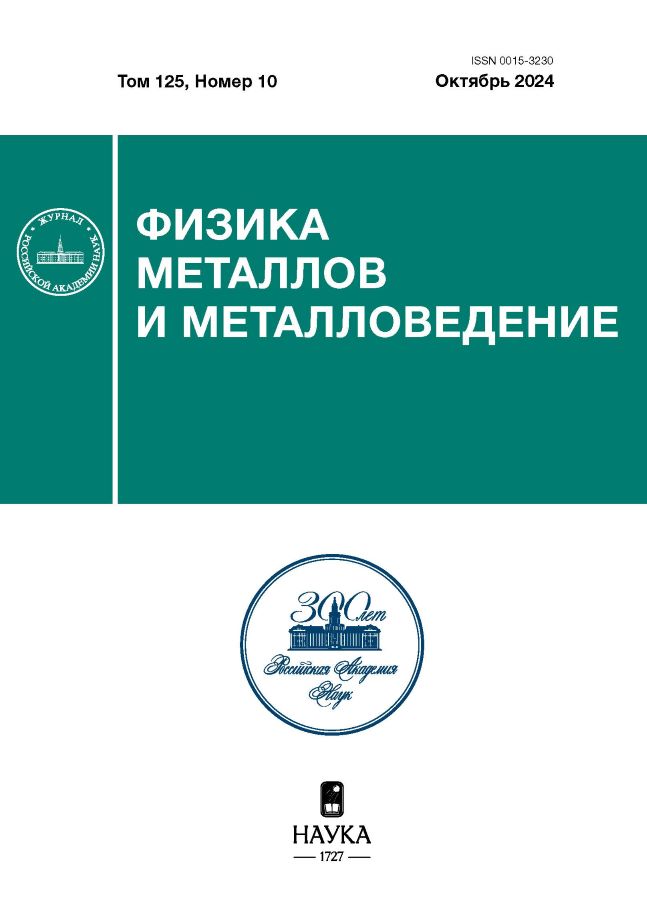The influence of quasi-transversive phonons on the electron-phonon drag thermopower in noble metals
- Authors: Kuleyev I.G.1, Kuleyev I.I.1
-
Affiliations:
- Mikheev Institute of Metal Physics, Ural Branch, Russian Academy of Sciences
- Issue: Vol 125, No 10 (2024)
- Pages: 1201-1207
- Section: ЭЛЕКТРИЧЕСКИЕ И МАГНИТНЫЕ СВОЙСТВА
- URL: https://innoscience.ru/0015-3230/article/view/681892
- DOI: https://doi.org/10.31857/S0015323024100012
- EDN: https://elibrary.ru/JGGGXS
- ID: 681892
Cite item
Abstract
The impact of elastic energy anisotropy on the drag thermopower in noble metals at low temperatures has been investigated. In order to describe the interaction of electrons with longitudinal phonons, the strain potential theory has been employed. In calculating electron relaxation on shear components of vibrational modes, the electron–phonon interaction constant, previously determined from a comparison of the calculated electrical resistivity of Au, Ag, and Cu bulk crystals with experimental data, was used. The maximum values of the drag thermopower in perfect noble metal crystals have been determined. These values are independent of the electron–phonon interaction constants; rather, they are determined by the elastic moduli of the second order, crystal density, and electron concentration. It has been demonstrated that quasi-transverse phonons constitute predominant contribution to the drag thermopower at low temperatures, whereas the contribution of longitudinal phonons were found to be negligible. At the same time, for perfect Au, Ag, and Cu crystals, the dominant contribution to the electron–phonon drag is provided by the slow t2-mode.
Keywords
Full Text
About the authors
I. G. Kuleyev
Mikheev Institute of Metal Physics, Ural Branch, Russian Academy of Sciences
Author for correspondence.
Email: kuleev@imp.uran.ru
Russian Federation, Ekaterinburg, 620108
I. I. Kuleyev
Mikheev Institute of Metal Physics, Ural Branch, Russian Academy of Sciences
Email: kuleev@imp.uran.ru
Russian Federation, Ekaterinburg, 620108
References
- Kuleyev I.G., Kuleyev I.I. The role of shear waves in electron – phonon relaxation and electrical resistivity of noble metals // Chinese J. Phys. 2023. V. 72. P. 351–359.
- Кулеев И.Г., Кулеев И.И. Роль квазипоперечных фононов и упругой анизотропии в термоэлектрических эффектах и электросопротивлении щелочных и благородных металлах. Екатеринбург: Издательство УМЦ УПИ, 2023. 205 с.
- Kuleyev I.I. and Kuleyev I.G. Effect of Anisotropy of Elastic Energy and Shear Waves on Electron–Phonon Relaxation and Electrical Resistivity of Noble Metals. Review 4 // Phys. Met. Metal. 2023. V. 124. Suppl. 1. Р. S86–S105.
- Peierls R.E. Quantum Theory of Solids. Oxford at clarendon press, 1955.
- Bloch F. Zum elektrischen Widerstandsgesetz bei tiefen Temperaturen // Zs. Fur Phys. 1930. V. 59. P. 208–214.
- Gruneisen E. Die Änderung des Druckkoeffizienten des metallischen Widerstandsmit der Temperatur // Ann. der Phys. 1941. V. 40. P. 543–552.
- Sommerfeld A., Bete H. Elektronen Theorie der Mettale. Handbuch der Physik, Bd. 24/2. 1934.
- Wilson A.H. The Theory of Metals. ed. Cambridge, 1953.
- Ziman J. Electrons and Phonons. Oxford, New York, 1960.
- Blatt F.J. Physics of electron conductivity in solids. McGRAW-HILL, BOOK COMPANY, 1968.
- Омельяновский О.Е., Заварицкий Н.В., Личкова Н.В., Матвеев В.Н. Кинетические свойства меди и серебра // ЖЭТФ. 1985. Т. 89. С. 696–709.
- MacDonald D.K.C., Pearson W.B., Templeton I.M. Thermo-electricity at low temperatures VII. Thermo-electricity of the alkali metals between 2 and 20°K // Proc. R. Soc. Lond. A. 1958. V. 248. P. 107–118.
- Zyman J.M. The thermoelectric power of the alkali metals at low temperatures // Phil. Mag. 1959. V. 4. P. 371–379.
- Guenault A. Thermoelectric power of silver alloys at very low temperatures // Philosoph. Magaz. 1967. V. 15 (133). P. 17–25.
- Guenault A.M. and Hawksworth D.G. Thermoelectric power of the pure noble metals at low temperatures // J. Phys. F: Met. Phys. 1977. V. 7. P. 219–222.
- Blatt F.J., Schroeder P.A., Foiles C.L., Greig D. Thermoelectric power of metals. New York and London: Plenum press, 1976.
- Кулеев И.Г., Кулеев И.И., Бахарев С.М., Устинов В.В. Фокусировка фононов и фононный транспорт в монокристаллических наноструктурах. Екатеринбург: “Издательство УМЦ УПИ”, 2018. 256 с.
- Truel B., Elbaum C., Chick B.B. Ultrasonic methods in solid state physics. N. Y. – London: Academic Press, 1969.
- Кулеев И.И., Кулеев И.Г. Роль сдвиговых волн в электрон-фононном увлечении в кристаллах калия при низких температурах // ФММ. 2020. Т. 121. № 10. С. 1011–1018.
- Jeno Gubicza, Chinh N.Q., Labar J.L., Heged Z., Langdon T.G. Twinning and dislocation activity in silver processed by severe plastic deformation // J. Mater. Sci. 2009. V. 44. P. 1656–1660.
- Жернов А.П., Инюшкин А.В. Изотопические эффекты в твердых телах. Москва: изд-во РНЦ “Курчатовский Институт”, 2001. 216 с.
- Klemens P.G. The scatterin of low-frequency lattice waves by static imperfactions // Proc. Phys. Soc. London, Sec. 1955. A 68. P. 1113–1128.
- Fletcher R. Scattering of phonons by dislocations in potassium // Phys. Rev. B. 1987. V. 36. P. 3042–3051.
Supplementary files












